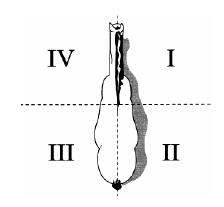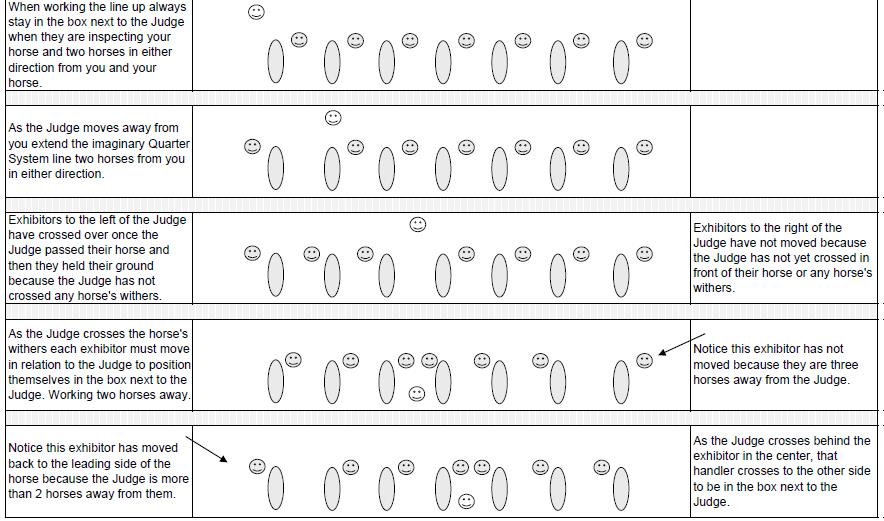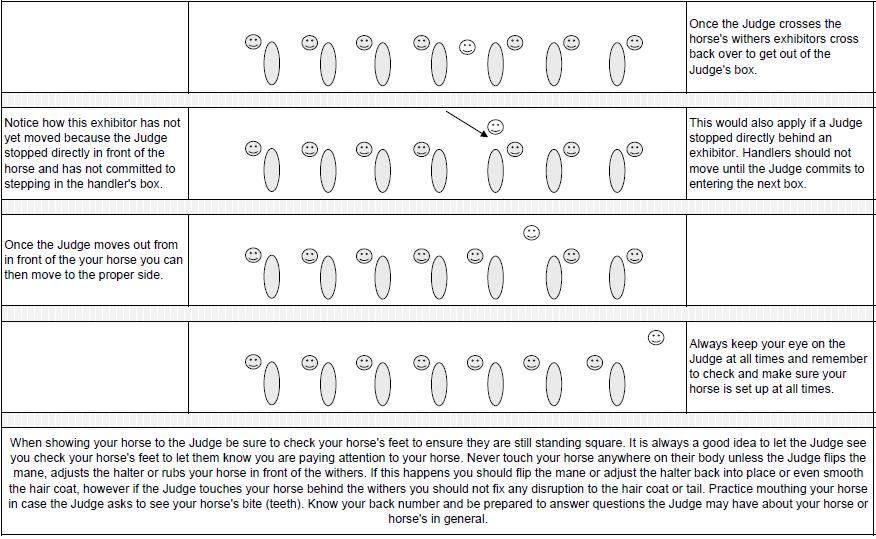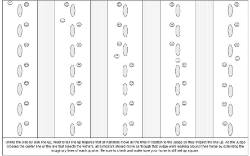HORSE SHOWMANSHIP
HORSE SHOWMANSHIP GUIDELINES
Acknowledgement: The information for this section is based on information from a showmanship clinic handout by Ashley Griffin, University of Kentucky and the Montana State Horse Show Guidelines , the Montana 4-H publication 5269 4-H Showmanship Guidelines.
Manners and actions in handling the horse reflect the amount of time and effort you spend in training. Showmanship is judged on the exhibitor’s ability to fit and show a horse at halter with the horse merely being a prop to demonstrate the ability and preparation of the exhibitor. It is not a halter class and should not be judged as such. The ideal performance consists of a poised, confident, neatly attired exhibitor leading a well-groomed and conditioned horse that quickly and efficiently performs the pattern with promptness, smoothness, and precision.
Grooming Horses
- The hair coat should be cleaned, well-brushed and free of dust, dandruff, manure stains and fly eggs. The hair coat should have a natural luster, so excessive oils from spray cans and other products will be counted down.
- Feet & Legs: The hair around the fetlock point is trimmed to give the legs a neater/cleaner appearance. The legs may be clipped from just below the knees and hocks down the hoof head. Run the clippers with the natural lay of the hair. Clipping a couple of weeks before the show will allow the hair to grow enough to eliminate clipper marks and contrasting shades of color.
- Head & Neck: The front edge of the ear should be trimmed. Do not clip the hair inside the ear; it is there for a reason. The whiskers and long hair around the muzzle and under the jaw should be trimmed. The horse’s mane should complement the horse and should be trained to fall properly on one side or the other of the neck. If shown with a mane, an appropriate bridle path should be clipped. A good rule of thumb is for the length of the bridle path to equal the length of the horse’s ear.
- Tail: The tail should be neat and clean. Tail length is a personal preference but should be trimmed and thinned to fit the horse. The hair is pulled, working on the longest hairs and mostly on the underside of the tail.
- Hooves: The hooves should be cleaned and properly. No preference will be taken for hoof dressing or coloring.
- Tack: Tack should be neat, clean and properly adjusted to fit your horse. Tack should complement, not detract from the horse. No preference shall be shown for elaborate, expensive tack.
Showing Horses
Equipment:
Halter and Lead: Horse must be shown with a properly adjusted halter. Lead shanks with chains may be used, but the use of the chain over the nose or under the jaw or in any way having contact with the horse will be prohibited. A chain 15 to 24 inches is long enough. Lead should be 6 to 10 feet long. Be sure the lead is long enough to allow picking up a hind foot.
NOTE: Whips, bat, or bridles will not be allowed. Tack should complement, not distract from the horse.
Showing Procedures
- All exhibitors will be asked to perform a pattern. Exhibitors may enter the ring as a group and then worked individually or may be worked from the gate. The following maneuvers are acceptable: walk, trot, hindquarter pivots, set up squarely, move forward and backward freely. The showman may be asked to pick up any or all feet of his/her horse and know the parts of their horse.
- Enter the arena as directed by the judge, ring steward, or announcer, typically in a counterclockwise direction. A showmanship class may begin one of two ways: 1) all exhibitors walk into the area one after another and move to the left forming a circle around the judge until they are asked to line up side by side before performing a pattern, 2) or they enter the area individually and perform the pattern first then line up side-by-side or head-to-tail.
- Walk briskly and businesslike with your shoulder to the middle of the neck on your horse and the horse’s head about an arm’s length to the right of your shoulder.
- The exhibitor should lead from the left side of the horse with the lead shank held in the right hand about 4 to 8 inches from the halter with the end folded in a figure-8 in the left hand. Do not coil the lead or fasten it with a rubber band in a figure 8.
- The horse should neither be ahead of the exhibitor nor should he/she be dragged along.
- At the judge’s discretion, the finalist in each class may be called back into the area for further work.
- Leave at least 10 feet (one horse length) between you and the horse in front of you.
- If necessary, pass on the inside and return to the rail.
- The exhibitor must never obstruct the judge’s view of the horse. This means the exhibit must position his body either front left or front right of the horse, using the quarter system.
SETTING UP YOUR ANIMAL:
- Set up your horse with all 4 feet square or according to breed type. The horse’s head should be up, and its weight should be on all 4 feet.
- The front feet and back feet should be parallel to and at the same approximate width from one another.
- The handler should stand to the side of the horse with their feet pointing towards their horse’s feet with a slight bend at the waist towards the horse’s head.
- Square the hind feet first by lowering your hand and moving the lead strap forwards and backwards in small, light motions.
- Once the hindquarters are set, do the same for the front feet except this time raise your hand slightly before moving the front feet.
- The horse will need practice for the square to become automatic.
- Quiet voice command may be used.
POSING WITH YOUR ANIMAL:
- When the horse is set up, the exhibitor should face the horse diagonally at a 45-degree angle off the horse’s shoulder in front and to the side of the head, moving from side to side as necessary. Be in a position to see your horse and keep eye contact with the judge without blocking the judge’s view or standing directly in front of your horse.
- When the judge inspects your horse, respond to his or her movements with the quartering system by mentally dividing the horse into 4 quarters.
- Change sides when the judge is at the heartgirth and when the judge crosses the tail and the nose. You should step around the horse’s head quickly and quietly, using 3 or 4 steps and keeping eye contact with the judge. Do not change hands on the lead when you change sides, and never stand in front of your horse in the “danger zone”.
- Do not let the horse “go to sleep” or cock a foot, but do not do anything that will attract attention (i.e. Throw dirt or wave your hat).
The Quarter System

The handler never stands in the II or III quarters but moves from I and IV as the judge inspects the horse.
Every time the judge crosses an imaginary line, the handler switches sides.
For example: The horse is standing square, and the judge begins to circle the horse and inspect the grooming job. He/She is in I, and you (the handler) are in IV. When the judge crosses the wither line, into II, you step from IV into I. When the judge passes the tail line into III, you step back from I into IV. When the judge crosses from III into IV, you go back to I. When the judge crosses directly in front of the horse, you cross in front of him back to IV.
|
Maneuver |
Horse |
Exhibitor |
|
Walk and Stop |
The horse should step off into a walk when the handler steps forward and should stop when the handler stops and faces the horse. Straight lines are important. |
The handler should be consistent and always stand facing their horse when they are stopped so when they turn to walk forward the horse will follow. Lead your horse directly to the judge so they can see how your horse travels. Do not walk yourself to the judge. Your shoulder should be at your horse’s throatlatch when walking. |
|
Trot |
The horse should step off into a trot when the handler steps forward and should stop when the handler stops and faces the horse. Straight lines are important. |
The same consistency in body position applies as discussed above for the walk. When trotting, do not look back at your horse, your horse will want to stop or only walk. You must jog in order for your horse to trot beside you. Your shoulder should be at your horse’s throatlatch when trotting. Try not to lean too far forward when you jog. |
|
Pivot |
When turning your horse 90 degrees or more, you must push your horse away from you when leading on the horse’s left side. Horse should keep their bodies straight as they cross their left front leg over the right front leg while keeping their hindquarters stationary and pivoting on their right hind foot. |
A pivot is a forward momentum movement and you may need to stop your horse forward half a step before signaling with the lead shank and walking into your horse’s throatlatch to move them into the pivot. Do not push your horse back as this will cause your horse to back out of the pivot and lose their pivot foot. |
|
Pull Turn |
To demonstrate a more advance pivot you may be asked to pull your horse toward you while maintaining the horse’s straight body alignment as they pivot on their hindquarters. This is generally done for 90 degree turns. The horse’s front right foot should cross over the horse’s left front foot while keeping their hindquarters planted in one location. |
The handler must pull the horse’s head toward them as they back up to enable the horse to turn towards them in the pull turn. Like the pivot, the handler must make a large enough circle to enable the horse to plant their hindquarters to maintain a pivot foot. |
|
Back |
A horse should back a straight line ranging from a few steps up to three horse length to perform potential patterns (counting the movement of the front feet). A horse should not turn their head toward the handler, but rather keep straight body alignment as the back. Backing fast is not necessary, however does show control and an increase in difficulty and skill to the judge when preformed correctly. |
The handler should begin by walking toward the horse while applying pressure to the lead shank encouraging the horse to back. The handler should never be standing in front of the horse’s head but should stay to the side of the horse’s head. It is dangerous to stand directly in front of your horse. If the pattern includes “closing the back,” return to your position at the start of the back and balance your horse. Changing hands on the lead is optional. |



- If instructed to line up side-by-side leave 6 to 8 feet between horses if possible. This allows the judge to pass safely between horses and to have a good view of your horse. While in line, do not let you horse circle you. Always turn the horse away from you for turns 90 degrees or more.
- If asked to move to another position in line, back out quietly and promptly lead to the new position. Speak to the animal to prevent it from becoming startled when another horse is moved nearby.
- Listen carefully to instructions. When asked for your individual performance, follow the judge’s instructions. Be ready to move promptly when signaled. Lines should be straight, and you should remain 5 to 7 feet away from the judge.
- Exhibitors may touch their horses only when requested to perform side pass or forehand turn maneuvers (or to smooth the mane or forelock). This mean you must not touch your horse when asking for a haunch turn or back, nor pet your horse until the class is dismissed.
- A gelding may “let down” when standing relaxed; correct by moving him forward or back.
- You should not use your feet to touch the horse’s hooves to get it to set up, nor should you change hands on the lead to set up. If the horse moves out of position quickly reset it.
Follow all other General Showmanship Guidelines on pages 1-3, and the Montana 4-H State Horse Show Guidelines and county and show rules.
